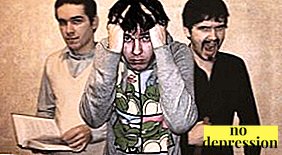Sometimes it happens that work, which previously brought a lot of positive emotions, seems senseless and even annoying.
At the same time a person can feel slump and indifference to their activities, moreover, this condition can progress with each passing day and in some cases lead to significant problems - up to a temporary loss of working capacity or a workplace.
Definition of basic concepts in psychology

What is professional burnout? What does it mean “burned out or burned out at work”?
Burnout syndrome (CMEA) is a condition characterized by emotional, physical and mental exhaustionwhich is accompanied by work stress.
As a result - not only the depressed state of the employee, lack of interest in the tasks, indifference to the result of their own work, but also the inevitable decrease in the labor potential of a person, a significant decrease in activity and the loss of the ability to solve complex tasks that require increased involvement in the work process.
Causes of condition
Emotional burnout can be thought of as body defense on the traumatic psyche phenomena. Thus, the body reduces energy consumption to external stimuli, protects the nervous, cardiovascular and endocrine systems from overstrain.
At the same time, some features of professional activity increase the chances of emotional burnout syndrome.
Psychologists distinguish the following causes provoking the emergence of the CMEA:
- Sedentary work requiring prolonged concentration.
- Routine activity, implying the performance of repetitive tasks.
- Work in a constant intense rhythm.
- Insufficient financial and psychological encouragement of the employee for the work performed.
- Insufficiently defined tasks.
- Both superfluous control from the management, and its absence, when it is necessary to solve problems above official competence.
- The inability to change any situation in the professional field for the better.

Inadequate rest from work, tense home atmosphere, lack of sleep, as well as unhealthy diet can increase the risks of burnout.
What workers are subject to this?
There are certain categories of people whose character traits imply predisposition to the CMEA. These include:
- Propensity to overestimate self-esteem, which leads to disappointment when it is impossible to achieve the desired results.
- Increased employee responsibility for their actions and propensity to sacrifice your personal interests for the sake of achieving professional goals.
- Perfectionism and maximalism, the need for the perfect performance of their work.

People who abuse alcohol, psychostimulants, or anti-depressants should be included in the risk zone.
Mainly, the CMEA is observed social workers - teachers, medical workers, employees of companies with a huge staff, all those whose work is associated with constant communication with people - for example, in the service sector.
This also includes creative professions - artists, poets, composers, writers, especially if their activities are not recognized in society for a long time.
Symptoms and signs
SEV does not appear suddenly - as a rule, they grow gradually. For this reason very difficult to diagnose them in the initial period. First, a person loses enthusiasm and motivation to do his job.
Contrary to desire, performing certain tasks is more time consuming than planned — this happens because lost concentration ability. Then comes a feeling of tiredness or irritation.

All symptoms of burnout can be divided into three groups:
Physiological:
- Constant fatigue, which does not pass even after a long sleep.
- Frequent headaches.
- Reduced immunity, manifested in susceptibility to infectious diseases.
- Increased sweating, even with slight physical exertion.
- Muscle weakness, rapidly advancing muscle fatigue.
- Sleep disturbance
- Recurring dizziness, darkening of the eyes.
- Weight fluctuations due to increased or decreased appetite.
At the same time, all of the above symptoms are not necessarily observed - they can manifest themselves depending on the individual characteristics of a person.
Psycho-emotional:
- Indifference to the events, lack of emotional reaction to them.
- The disappearance of motivation for professional activities.
- Disbelief in one’s own abilities, feeling of powerlessness.
- Frustration in ideals.
- Irritation towards close people, dissatisfaction with their behavior, outbursts of aggression without a tangible cause.
- Constantly bad mood.

In general, the psycho-emotional signs of the CMEA are very similar to depression, but the latter is much more difficult to overcome than burnout.
Behavioral:
- The desire to minimize contact with people.
- The desire to get away from professional responsibility, the refusal to perform their immediate duties.
- Denial of responsibility for what is happening, the desire to shift the blame for their own actions on the people around them.
- Negative attitude to everything happening, pessimistic forecasts for the future.
During this period, a person may be prone to alcohol abuse and addiction to drugs, as a way to get a positive emotional charge.
What to do?

How to cope with emotional burnout at work?
Treatment of emotional burnout is hampered by its diagnosis in the early period.
Many people blame everything for temporary sickness and seriously pay attention to the problem already with its progression.
The first thing to do when detecting the CMEA is minimize load. If necessary, take a vacation or even a sick-list from a doctor - as further work in this mode will only worsen the state of health.
If there is no opportunity to temporarily leave the workplace, then you need to try to minimize situations that require significant stress.
To do this, you need to revise your responsibilities, do not take overtime, not to shoulder the responsibilities of other colleagues - even if you have to say polite, but firm "no."
Also removing the symptoms of burnout at work will help the following:
- Please help for relatives - explain to them the situation and the need for rest. Only one conversation with a loved one can already significantly alleviate the stress state.
- Try hard leave impressions about the working day outside the house. While in your home environment, abstract as much as possible from your professional activities, switch to household chores.
- With significant mental stress at work change your free time activity - for example, pay attention to the sport.
- Sleep must be at least 8 hours a day.
- Organize full diet and the right diet.
- Select multiple activities that bring positive emotions - for example, fishing, traveling, skiing, any hobby - even if it requires some financial costs.

After recuperation, it is necessary to try to remove the factors that led to emotional burnout - if you leave the situation unchanged, it is likely that the CMEA will manifest itself some time later.
To do this, for example, ask for a surcharge in case of unsatisfactory remuneration, discuss with your colleagues the range of responsibilities if they “leave” for your sense of responsibility, and in some cases even change their profession.
If necessary, you should ask for a clear explanation of the tasks, discuss and approve various options for their solution.
If symptoms of burnout do not go away, the best consult a specialist - a psychologist or psychotherapist.
How to deal with the syndrome?

It is much easier to treat CMEA at work by taking timely measures to prevent them.
To do this, you must perform the following preventive measures:
Physiological:
- full sleep;
- balanced diet;
- adherence to the day;
- playing sports or walking in the fresh air;
- periodic change of occupation.
Psychological:
- Mandatory rest at least once a week, in which you can devote time to activities that bring moral satisfaction.
- Proper organization of working time - the allocation of priority tasks and their priority implementation.
- Qualitative improvement of the working environment after analyzing the associated problems - it should be remembered that everyone is entitled to their own comfort.
- Autotraining and motivational events.
- Meditation and relaxation. These practices will help get rid of mental stress after work.
- Rest from modern means of communication - you need to spend some time when the phone and computer are turned off, in silence.
- Timely Vacation, which should be carried out with an emphasis on pastime, bringing pleasure and pleasant emotions.

Psychologists recommend reconsider negative experiences - learn to accept failures correctly, not to focus attention on them, but to look for new sources of energy and motivation.
Also need be able to accept losses, because very often a lot of energy is spent on preserving things or following such concepts that do not have adequate value or recognition from others.
With the correct setting of life priorities and the implementation of preventive measures of burnout syndrome at work, it can be avoided, thereby preserving the motivation to work and the ability to achieve high results.
How not to lose interest in your business? Psychotherapy professional burnout:



